Starbucks Business Report
VerifiedAdded on 2023/01/17
|15
|5030
|1
AI Summary
This report provides an assessment of the business performance of Starbucks, including an overview of the company and its competitors, analysis of the external and internal environment, and recommendations for improvement.
Contribute Materials
Your contribution can guide someone’s learning journey. Share your
documents today.
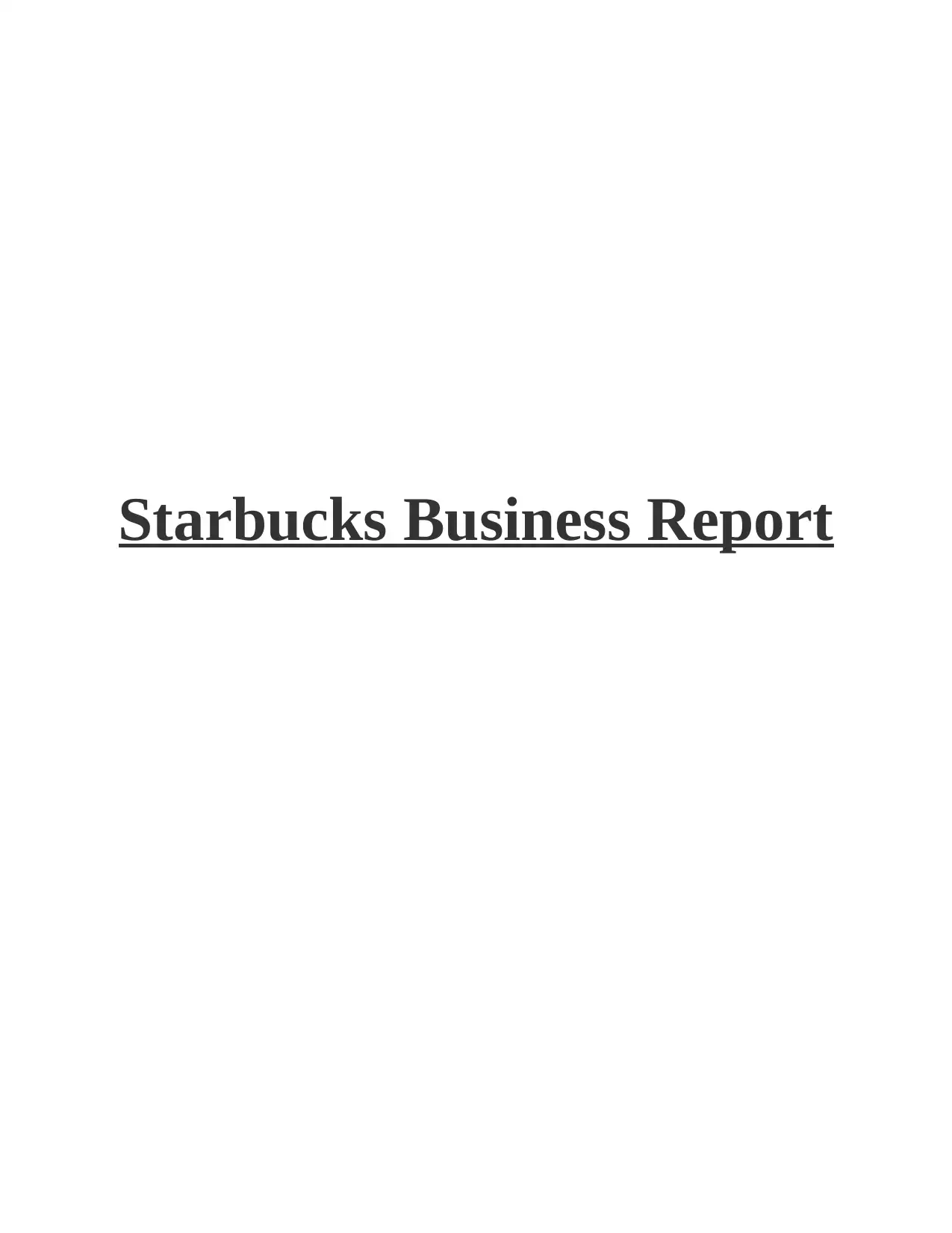
Starbucks Business Report
Secure Best Marks with AI Grader
Need help grading? Try our AI Grader for instant feedback on your assignments.
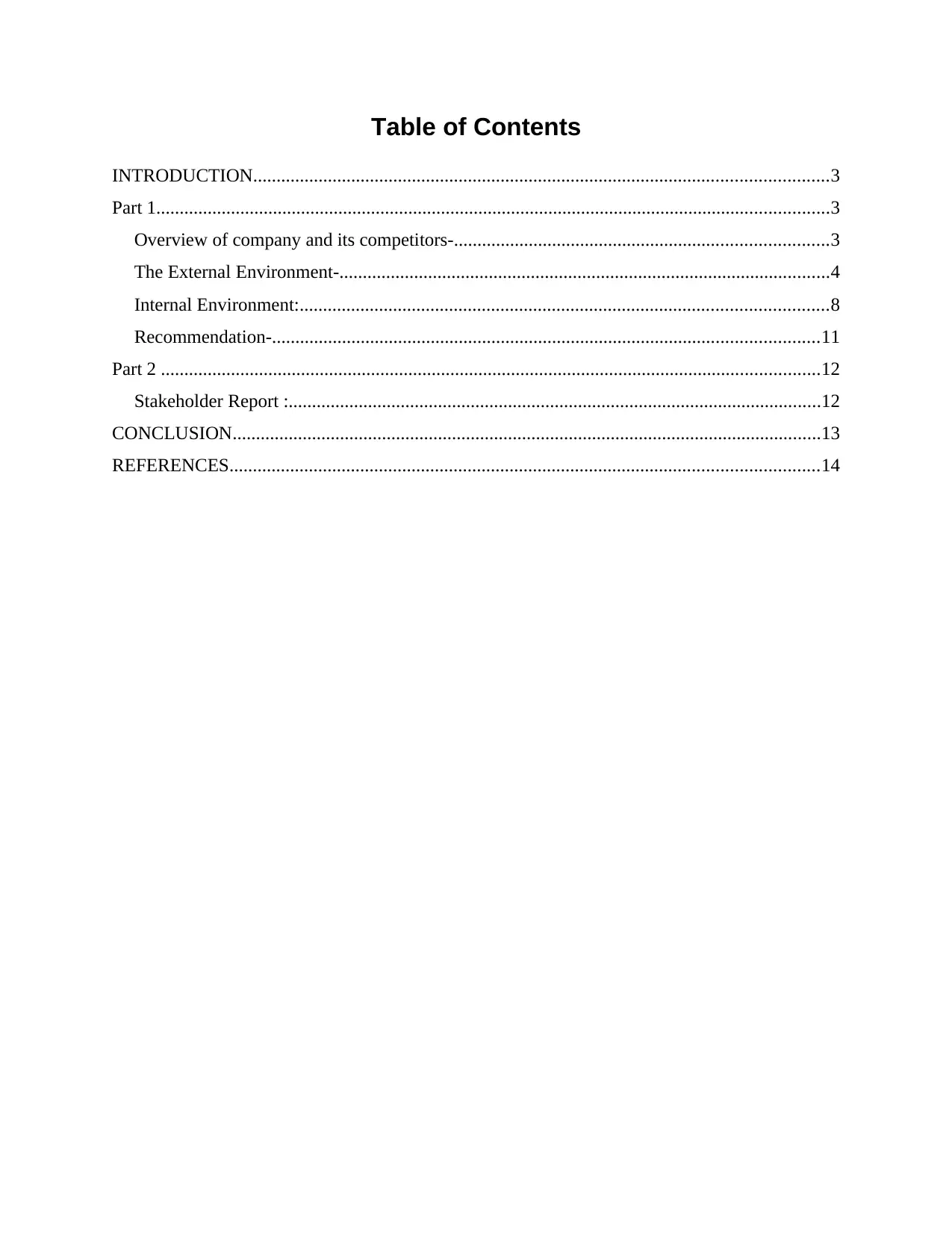
Table of Contents
INTRODUCTION...........................................................................................................................3
Part 1................................................................................................................................................3
Overview of company and its competitors-................................................................................3
The External Environment-.........................................................................................................4
Internal Environment:.................................................................................................................8
Recommendation-.....................................................................................................................11
Part 2 .............................................................................................................................................12
Stakeholder Report :..................................................................................................................12
CONCLUSION..............................................................................................................................13
REFERENCES..............................................................................................................................14
INTRODUCTION...........................................................................................................................3
Part 1................................................................................................................................................3
Overview of company and its competitors-................................................................................3
The External Environment-.........................................................................................................4
Internal Environment:.................................................................................................................8
Recommendation-.....................................................................................................................11
Part 2 .............................................................................................................................................12
Stakeholder Report :..................................................................................................................12
CONCLUSION..............................................................................................................................13
REFERENCES..............................................................................................................................14
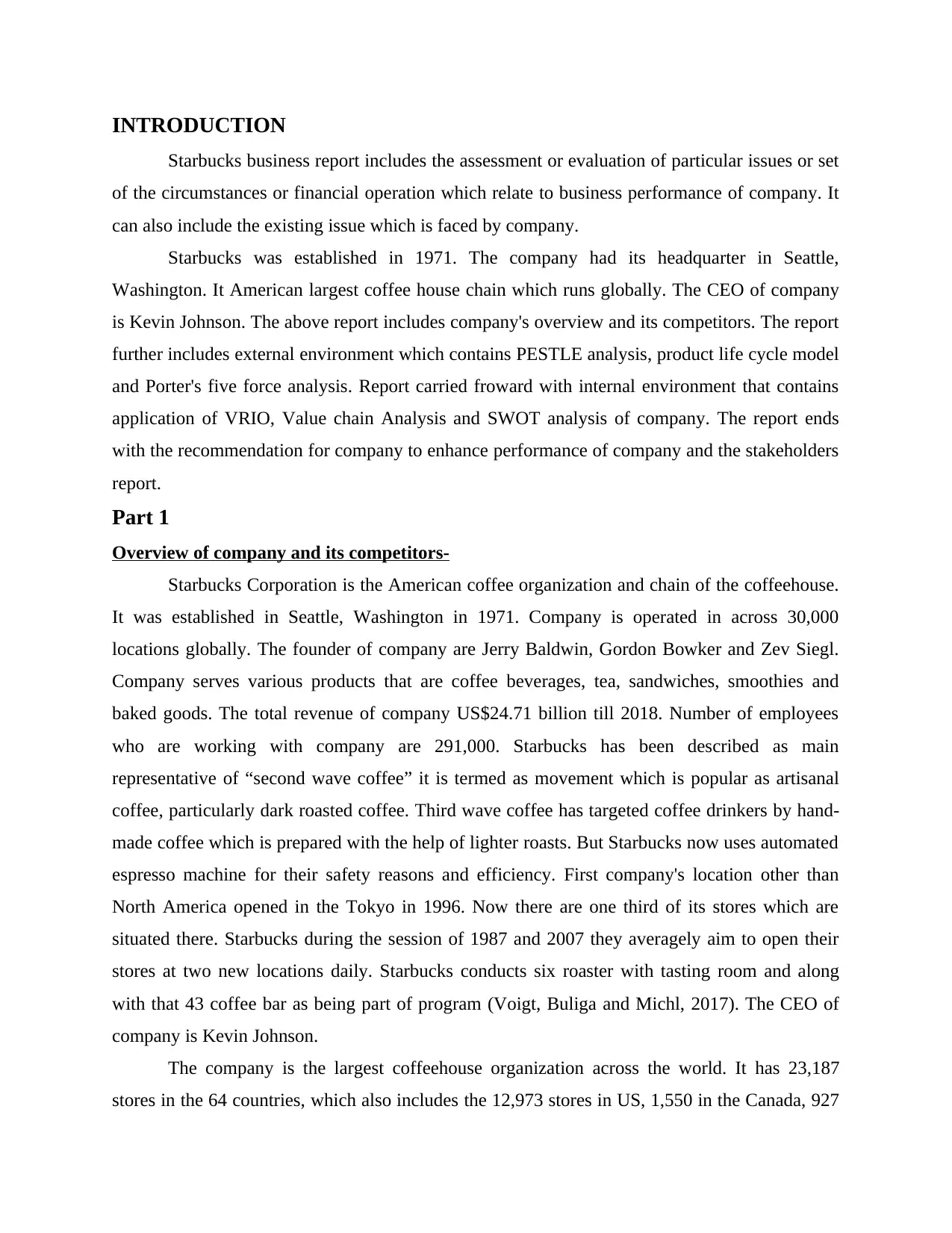
INTRODUCTION
Starbucks business report includes the assessment or evaluation of particular issues or set
of the circumstances or financial operation which relate to business performance of company. It
can also include the existing issue which is faced by company.
Starbucks was established in 1971. The company had its headquarter in Seattle,
Washington. It American largest coffee house chain which runs globally. The CEO of company
is Kevin Johnson. The above report includes company's overview and its competitors. The report
further includes external environment which contains PESTLE analysis, product life cycle model
and Porter's five force analysis. Report carried froward with internal environment that contains
application of VRIO, Value chain Analysis and SWOT analysis of company. The report ends
with the recommendation for company to enhance performance of company and the stakeholders
report.
Part 1
Overview of company and its competitors-
Starbucks Corporation is the American coffee organization and chain of the coffeehouse.
It was established in Seattle, Washington in 1971. Company is operated in across 30,000
locations globally. The founder of company are Jerry Baldwin, Gordon Bowker and Zev Siegl.
Company serves various products that are coffee beverages, tea, sandwiches, smoothies and
baked goods. The total revenue of company US$24.71 billion till 2018. Number of employees
who are working with company are 291,000. Starbucks has been described as main
representative of “second wave coffee” it is termed as movement which is popular as artisanal
coffee, particularly dark roasted coffee. Third wave coffee has targeted coffee drinkers by hand-
made coffee which is prepared with the help of lighter roasts. But Starbucks now uses automated
espresso machine for their safety reasons and efficiency. First company's location other than
North America opened in the Tokyo in 1996. Now there are one third of its stores which are
situated there. Starbucks during the session of 1987 and 2007 they averagely aim to open their
stores at two new locations daily. Starbucks conducts six roaster with tasting room and along
with that 43 coffee bar as being part of program (Voigt, Buliga and Michl, 2017). The CEO of
company is Kevin Johnson.
The company is the largest coffeehouse organization across the world. It has 23,187
stores in the 64 countries, which also includes the 12,973 stores in US, 1,550 in the Canada, 927
Starbucks business report includes the assessment or evaluation of particular issues or set
of the circumstances or financial operation which relate to business performance of company. It
can also include the existing issue which is faced by company.
Starbucks was established in 1971. The company had its headquarter in Seattle,
Washington. It American largest coffee house chain which runs globally. The CEO of company
is Kevin Johnson. The above report includes company's overview and its competitors. The report
further includes external environment which contains PESTLE analysis, product life cycle model
and Porter's five force analysis. Report carried froward with internal environment that contains
application of VRIO, Value chain Analysis and SWOT analysis of company. The report ends
with the recommendation for company to enhance performance of company and the stakeholders
report.
Part 1
Overview of company and its competitors-
Starbucks Corporation is the American coffee organization and chain of the coffeehouse.
It was established in Seattle, Washington in 1971. Company is operated in across 30,000
locations globally. The founder of company are Jerry Baldwin, Gordon Bowker and Zev Siegl.
Company serves various products that are coffee beverages, tea, sandwiches, smoothies and
baked goods. The total revenue of company US$24.71 billion till 2018. Number of employees
who are working with company are 291,000. Starbucks has been described as main
representative of “second wave coffee” it is termed as movement which is popular as artisanal
coffee, particularly dark roasted coffee. Third wave coffee has targeted coffee drinkers by hand-
made coffee which is prepared with the help of lighter roasts. But Starbucks now uses automated
espresso machine for their safety reasons and efficiency. First company's location other than
North America opened in the Tokyo in 1996. Now there are one third of its stores which are
situated there. Starbucks during the session of 1987 and 2007 they averagely aim to open their
stores at two new locations daily. Starbucks conducts six roaster with tasting room and along
with that 43 coffee bar as being part of program (Voigt, Buliga and Michl, 2017). The CEO of
company is Kevin Johnson.
The company is the largest coffeehouse organization across the world. It has 23,187
stores in the 64 countries, which also includes the 12,973 stores in US, 1,550 in the Canada, 927
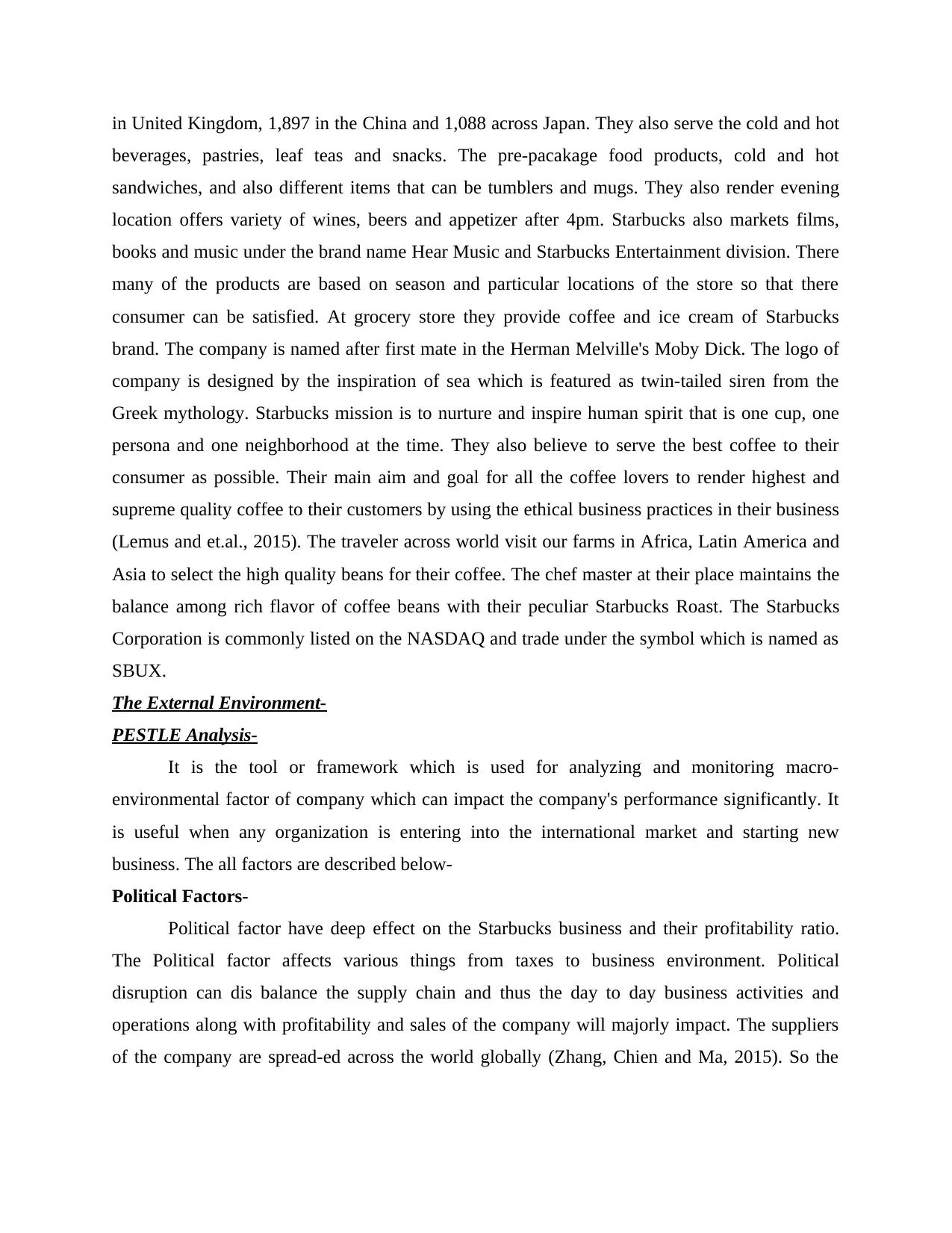
in United Kingdom, 1,897 in the China and 1,088 across Japan. They also serve the cold and hot
beverages, pastries, leaf teas and snacks. The pre-pacakage food products, cold and hot
sandwiches, and also different items that can be tumblers and mugs. They also render evening
location offers variety of wines, beers and appetizer after 4pm. Starbucks also markets films,
books and music under the brand name Hear Music and Starbucks Entertainment division. There
many of the products are based on season and particular locations of the store so that there
consumer can be satisfied. At grocery store they provide coffee and ice cream of Starbucks
brand. The company is named after first mate in the Herman Melville's Moby Dick. The logo of
company is designed by the inspiration of sea which is featured as twin-tailed siren from the
Greek mythology. Starbucks mission is to nurture and inspire human spirit that is one cup, one
persona and one neighborhood at the time. They also believe to serve the best coffee to their
consumer as possible. Their main aim and goal for all the coffee lovers to render highest and
supreme quality coffee to their customers by using the ethical business practices in their business
(Lemus and et.al., 2015). The traveler across world visit our farms in Africa, Latin America and
Asia to select the high quality beans for their coffee. The chef master at their place maintains the
balance among rich flavor of coffee beans with their peculiar Starbucks Roast. The Starbucks
Corporation is commonly listed on the NASDAQ and trade under the symbol which is named as
SBUX.
The External Environment-
PESTLE Analysis-
It is the tool or framework which is used for analyzing and monitoring macro-
environmental factor of company which can impact the company's performance significantly. It
is useful when any organization is entering into the international market and starting new
business. The all factors are described below-
Political Factors-
Political factor have deep effect on the Starbucks business and their profitability ratio.
The Political factor affects various things from taxes to business environment. Political
disruption can dis balance the supply chain and thus the day to day business activities and
operations along with profitability and sales of the company will majorly impact. The suppliers
of the company are spread-ed across the world globally (Zhang, Chien and Ma, 2015). So the
beverages, pastries, leaf teas and snacks. The pre-pacakage food products, cold and hot
sandwiches, and also different items that can be tumblers and mugs. They also render evening
location offers variety of wines, beers and appetizer after 4pm. Starbucks also markets films,
books and music under the brand name Hear Music and Starbucks Entertainment division. There
many of the products are based on season and particular locations of the store so that there
consumer can be satisfied. At grocery store they provide coffee and ice cream of Starbucks
brand. The company is named after first mate in the Herman Melville's Moby Dick. The logo of
company is designed by the inspiration of sea which is featured as twin-tailed siren from the
Greek mythology. Starbucks mission is to nurture and inspire human spirit that is one cup, one
persona and one neighborhood at the time. They also believe to serve the best coffee to their
consumer as possible. Their main aim and goal for all the coffee lovers to render highest and
supreme quality coffee to their customers by using the ethical business practices in their business
(Lemus and et.al., 2015). The traveler across world visit our farms in Africa, Latin America and
Asia to select the high quality beans for their coffee. The chef master at their place maintains the
balance among rich flavor of coffee beans with their peculiar Starbucks Roast. The Starbucks
Corporation is commonly listed on the NASDAQ and trade under the symbol which is named as
SBUX.
The External Environment-
PESTLE Analysis-
It is the tool or framework which is used for analyzing and monitoring macro-
environmental factor of company which can impact the company's performance significantly. It
is useful when any organization is entering into the international market and starting new
business. The all factors are described below-
Political Factors-
Political factor have deep effect on the Starbucks business and their profitability ratio.
The Political factor affects various things from taxes to business environment. Political
disruption can dis balance the supply chain and thus the day to day business activities and
operations along with profitability and sales of the company will majorly impact. The suppliers
of the company are spread-ed across the world globally (Zhang, Chien and Ma, 2015). So the
Secure Best Marks with AI Grader
Need help grading? Try our AI Grader for instant feedback on your assignments.
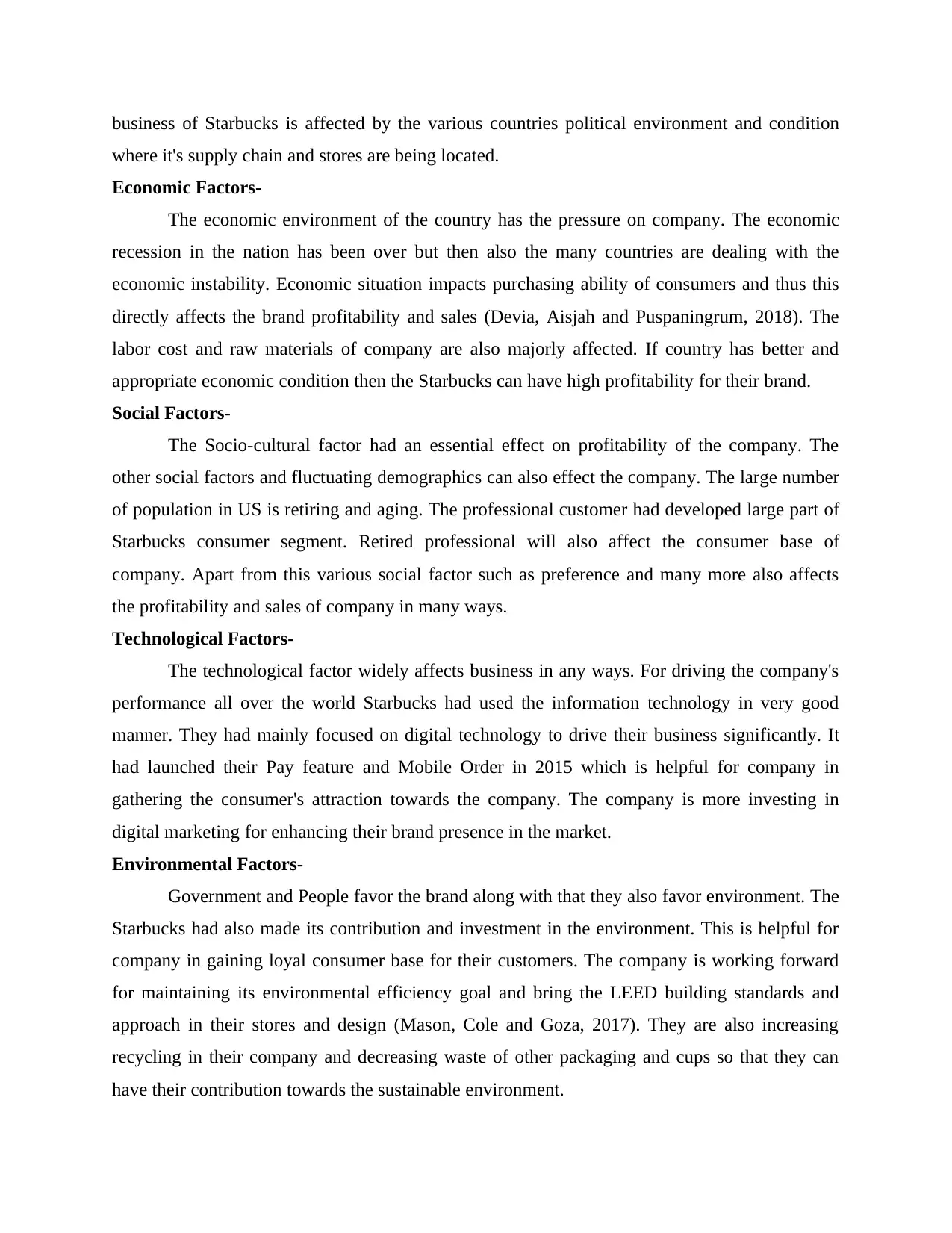
business of Starbucks is affected by the various countries political environment and condition
where it's supply chain and stores are being located.
Economic Factors-
The economic environment of the country has the pressure on company. The economic
recession in the nation has been over but then also the many countries are dealing with the
economic instability. Economic situation impacts purchasing ability of consumers and thus this
directly affects the brand profitability and sales (Devia, Aisjah and Puspaningrum, 2018). The
labor cost and raw materials of company are also majorly affected. If country has better and
appropriate economic condition then the Starbucks can have high profitability for their brand.
Social Factors-
The Socio-cultural factor had an essential effect on profitability of the company. The
other social factors and fluctuating demographics can also effect the company. The large number
of population in US is retiring and aging. The professional customer had developed large part of
Starbucks consumer segment. Retired professional will also affect the consumer base of
company. Apart from this various social factor such as preference and many more also affects
the profitability and sales of company in many ways.
Technological Factors-
The technological factor widely affects business in any ways. For driving the company's
performance all over the world Starbucks had used the information technology in very good
manner. They had mainly focused on digital technology to drive their business significantly. It
had launched their Pay feature and Mobile Order in 2015 which is helpful for company in
gathering the consumer's attraction towards the company. The company is more investing in
digital marketing for enhancing their brand presence in the market.
Environmental Factors-
Government and People favor the brand along with that they also favor environment. The
Starbucks had also made its contribution and investment in the environment. This is helpful for
company in gaining loyal consumer base for their customers. The company is working forward
for maintaining its environmental efficiency goal and bring the LEED building standards and
approach in their stores and design (Mason, Cole and Goza, 2017). They are also increasing
recycling in their company and decreasing waste of other packaging and cups so that they can
have their contribution towards the sustainable environment.
where it's supply chain and stores are being located.
Economic Factors-
The economic environment of the country has the pressure on company. The economic
recession in the nation has been over but then also the many countries are dealing with the
economic instability. Economic situation impacts purchasing ability of consumers and thus this
directly affects the brand profitability and sales (Devia, Aisjah and Puspaningrum, 2018). The
labor cost and raw materials of company are also majorly affected. If country has better and
appropriate economic condition then the Starbucks can have high profitability for their brand.
Social Factors-
The Socio-cultural factor had an essential effect on profitability of the company. The
other social factors and fluctuating demographics can also effect the company. The large number
of population in US is retiring and aging. The professional customer had developed large part of
Starbucks consumer segment. Retired professional will also affect the consumer base of
company. Apart from this various social factor such as preference and many more also affects
the profitability and sales of company in many ways.
Technological Factors-
The technological factor widely affects business in any ways. For driving the company's
performance all over the world Starbucks had used the information technology in very good
manner. They had mainly focused on digital technology to drive their business significantly. It
had launched their Pay feature and Mobile Order in 2015 which is helpful for company in
gathering the consumer's attraction towards the company. The company is more investing in
digital marketing for enhancing their brand presence in the market.
Environmental Factors-
Government and People favor the brand along with that they also favor environment. The
Starbucks had also made its contribution and investment in the environment. This is helpful for
company in gaining loyal consumer base for their customers. The company is working forward
for maintaining its environmental efficiency goal and bring the LEED building standards and
approach in their stores and design (Mason, Cole and Goza, 2017). They are also increasing
recycling in their company and decreasing waste of other packaging and cups so that they can
have their contribution towards the sustainable environment.
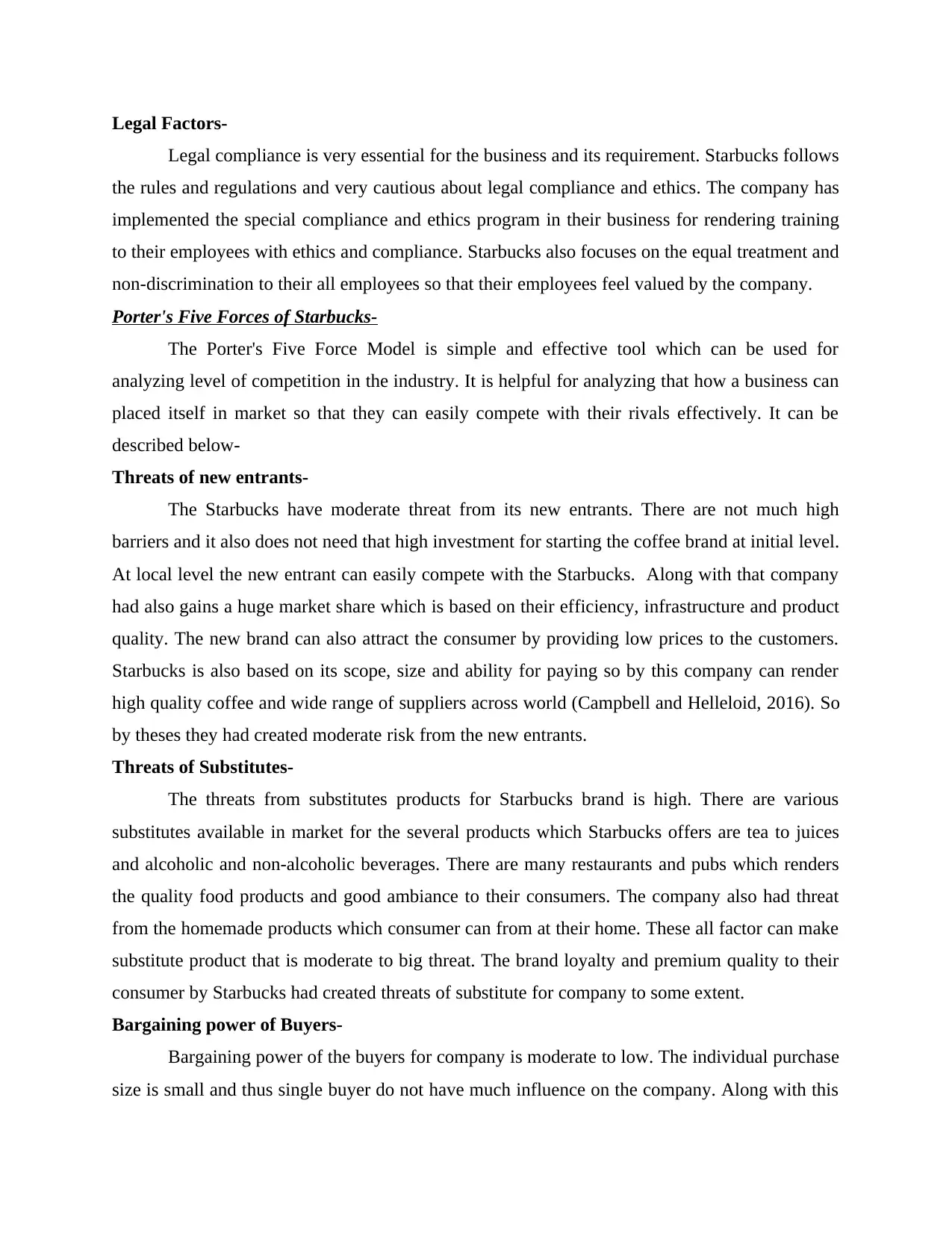
Legal Factors-
Legal compliance is very essential for the business and its requirement. Starbucks follows
the rules and regulations and very cautious about legal compliance and ethics. The company has
implemented the special compliance and ethics program in their business for rendering training
to their employees with ethics and compliance. Starbucks also focuses on the equal treatment and
non-discrimination to their all employees so that their employees feel valued by the company.
Porter's Five Forces of Starbucks-
The Porter's Five Force Model is simple and effective tool which can be used for
analyzing level of competition in the industry. It is helpful for analyzing that how a business can
placed itself in market so that they can easily compete with their rivals effectively. It can be
described below-
Threats of new entrants-
The Starbucks have moderate threat from its new entrants. There are not much high
barriers and it also does not need that high investment for starting the coffee brand at initial level.
At local level the new entrant can easily compete with the Starbucks. Along with that company
had also gains a huge market share which is based on their efficiency, infrastructure and product
quality. The new brand can also attract the consumer by providing low prices to the customers.
Starbucks is also based on its scope, size and ability for paying so by this company can render
high quality coffee and wide range of suppliers across world (Campbell and Helleloid, 2016). So
by theses they had created moderate risk from the new entrants.
Threats of Substitutes-
The threats from substitutes products for Starbucks brand is high. There are various
substitutes available in market for the several products which Starbucks offers are tea to juices
and alcoholic and non-alcoholic beverages. There are many restaurants and pubs which renders
the quality food products and good ambiance to their consumers. The company also had threat
from the homemade products which consumer can from at their home. These all factor can make
substitute product that is moderate to big threat. The brand loyalty and premium quality to their
consumer by Starbucks had created threats of substitute for company to some extent.
Bargaining power of Buyers-
Bargaining power of the buyers for company is moderate to low. The individual purchase
size is small and thus single buyer do not have much influence on the company. Along with this
Legal compliance is very essential for the business and its requirement. Starbucks follows
the rules and regulations and very cautious about legal compliance and ethics. The company has
implemented the special compliance and ethics program in their business for rendering training
to their employees with ethics and compliance. Starbucks also focuses on the equal treatment and
non-discrimination to their all employees so that their employees feel valued by the company.
Porter's Five Forces of Starbucks-
The Porter's Five Force Model is simple and effective tool which can be used for
analyzing level of competition in the industry. It is helpful for analyzing that how a business can
placed itself in market so that they can easily compete with their rivals effectively. It can be
described below-
Threats of new entrants-
The Starbucks have moderate threat from its new entrants. There are not much high
barriers and it also does not need that high investment for starting the coffee brand at initial level.
At local level the new entrant can easily compete with the Starbucks. Along with that company
had also gains a huge market share which is based on their efficiency, infrastructure and product
quality. The new brand can also attract the consumer by providing low prices to the customers.
Starbucks is also based on its scope, size and ability for paying so by this company can render
high quality coffee and wide range of suppliers across world (Campbell and Helleloid, 2016). So
by theses they had created moderate risk from the new entrants.
Threats of Substitutes-
The threats from substitutes products for Starbucks brand is high. There are various
substitutes available in market for the several products which Starbucks offers are tea to juices
and alcoholic and non-alcoholic beverages. There are many restaurants and pubs which renders
the quality food products and good ambiance to their consumers. The company also had threat
from the homemade products which consumer can from at their home. These all factor can make
substitute product that is moderate to big threat. The brand loyalty and premium quality to their
consumer by Starbucks had created threats of substitute for company to some extent.
Bargaining power of Buyers-
Bargaining power of the buyers for company is moderate to low. The individual purchase
size is small and thus single buyer do not have much influence on the company. Along with this
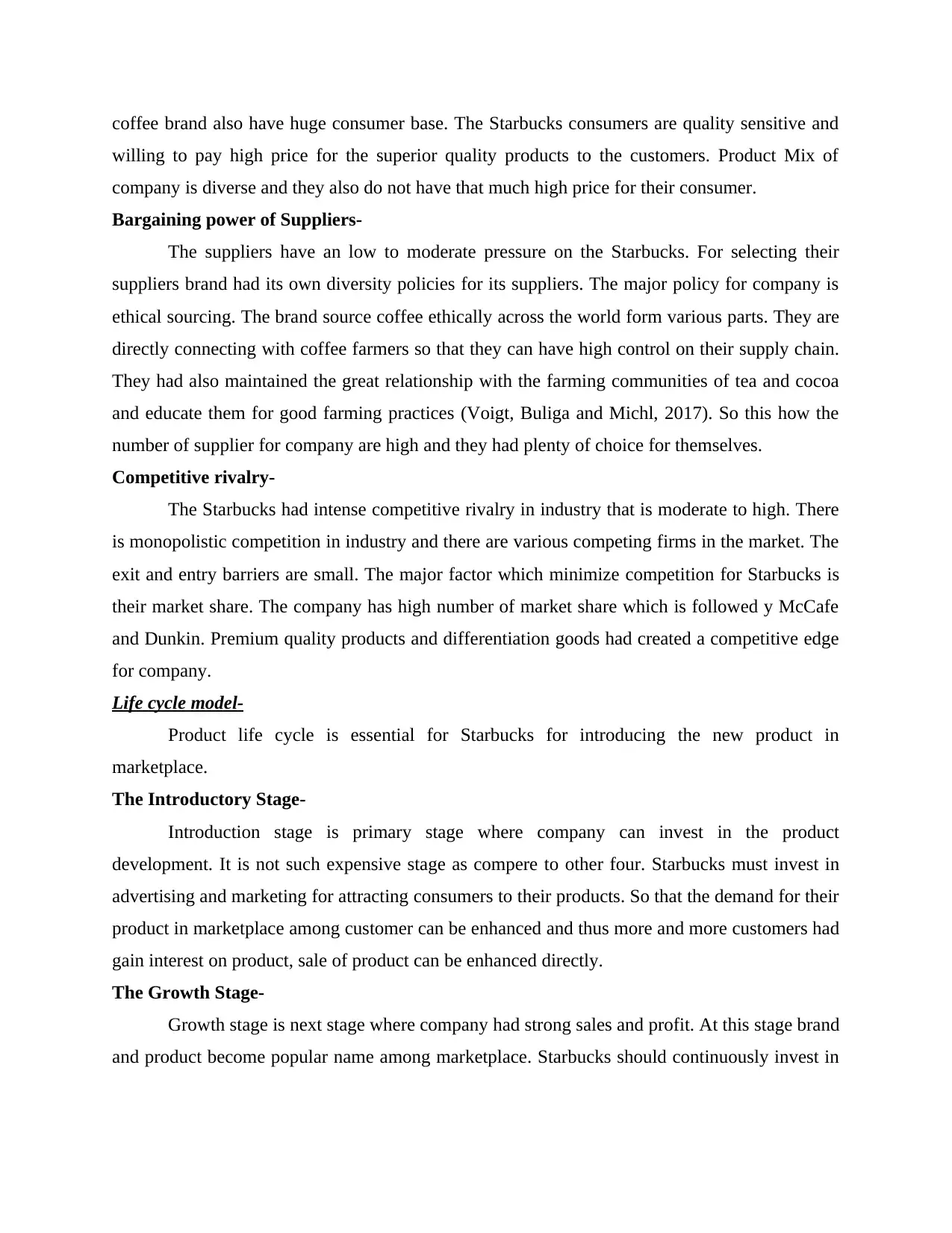
coffee brand also have huge consumer base. The Starbucks consumers are quality sensitive and
willing to pay high price for the superior quality products to the customers. Product Mix of
company is diverse and they also do not have that much high price for their consumer.
Bargaining power of Suppliers-
The suppliers have an low to moderate pressure on the Starbucks. For selecting their
suppliers brand had its own diversity policies for its suppliers. The major policy for company is
ethical sourcing. The brand source coffee ethically across the world form various parts. They are
directly connecting with coffee farmers so that they can have high control on their supply chain.
They had also maintained the great relationship with the farming communities of tea and cocoa
and educate them for good farming practices (Voigt, Buliga and Michl, 2017). So this how the
number of supplier for company are high and they had plenty of choice for themselves.
Competitive rivalry-
The Starbucks had intense competitive rivalry in industry that is moderate to high. There
is monopolistic competition in industry and there are various competing firms in the market. The
exit and entry barriers are small. The major factor which minimize competition for Starbucks is
their market share. The company has high number of market share which is followed y McCafe
and Dunkin. Premium quality products and differentiation goods had created a competitive edge
for company.
Life cycle model-
Product life cycle is essential for Starbucks for introducing the new product in
marketplace.
The Introductory Stage-
Introduction stage is primary stage where company can invest in the product
development. It is not such expensive stage as compere to other four. Starbucks must invest in
advertising and marketing for attracting consumers to their products. So that the demand for their
product in marketplace among customer can be enhanced and thus more and more customers had
gain interest on product, sale of product can be enhanced directly.
The Growth Stage-
Growth stage is next stage where company had strong sales and profit. At this stage brand
and product become popular name among marketplace. Starbucks should continuously invest in
willing to pay high price for the superior quality products to the customers. Product Mix of
company is diverse and they also do not have that much high price for their consumer.
Bargaining power of Suppliers-
The suppliers have an low to moderate pressure on the Starbucks. For selecting their
suppliers brand had its own diversity policies for its suppliers. The major policy for company is
ethical sourcing. The brand source coffee ethically across the world form various parts. They are
directly connecting with coffee farmers so that they can have high control on their supply chain.
They had also maintained the great relationship with the farming communities of tea and cocoa
and educate them for good farming practices (Voigt, Buliga and Michl, 2017). So this how the
number of supplier for company are high and they had plenty of choice for themselves.
Competitive rivalry-
The Starbucks had intense competitive rivalry in industry that is moderate to high. There
is monopolistic competition in industry and there are various competing firms in the market. The
exit and entry barriers are small. The major factor which minimize competition for Starbucks is
their market share. The company has high number of market share which is followed y McCafe
and Dunkin. Premium quality products and differentiation goods had created a competitive edge
for company.
Life cycle model-
Product life cycle is essential for Starbucks for introducing the new product in
marketplace.
The Introductory Stage-
Introduction stage is primary stage where company can invest in the product
development. It is not such expensive stage as compere to other four. Starbucks must invest in
advertising and marketing for attracting consumers to their products. So that the demand for their
product in marketplace among customer can be enhanced and thus more and more customers had
gain interest on product, sale of product can be enhanced directly.
The Growth Stage-
Growth stage is next stage where company had strong sales and profit. At this stage brand
and product become popular name among marketplace. Starbucks should continuously invest in
Paraphrase This Document
Need a fresh take? Get an instant paraphrase of this document with our AI Paraphraser
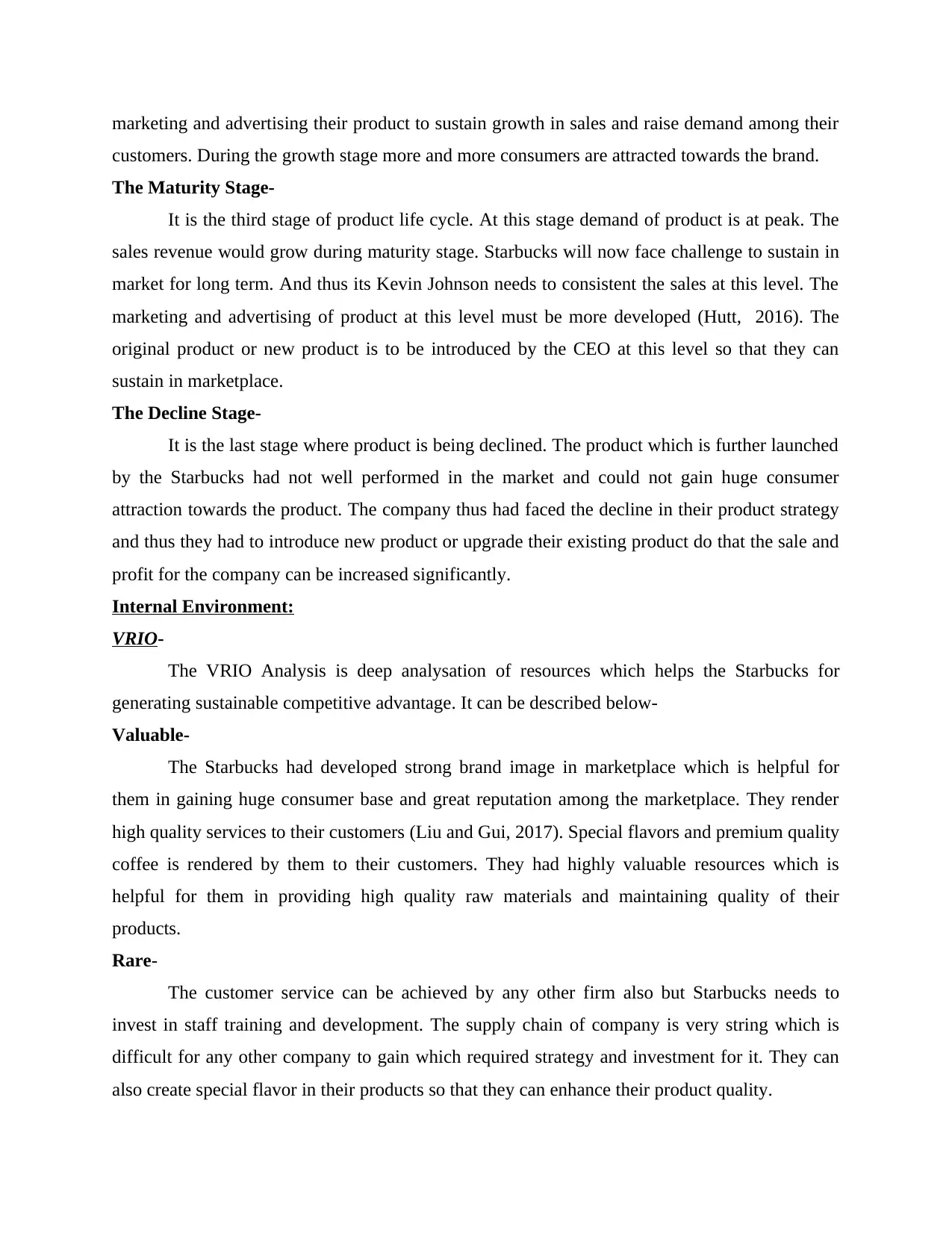
marketing and advertising their product to sustain growth in sales and raise demand among their
customers. During the growth stage more and more consumers are attracted towards the brand.
The Maturity Stage-
It is the third stage of product life cycle. At this stage demand of product is at peak. The
sales revenue would grow during maturity stage. Starbucks will now face challenge to sustain in
market for long term. And thus its Kevin Johnson needs to consistent the sales at this level. The
marketing and advertising of product at this level must be more developed (Hutt, 2016). The
original product or new product is to be introduced by the CEO at this level so that they can
sustain in marketplace.
The Decline Stage-
It is the last stage where product is being declined. The product which is further launched
by the Starbucks had not well performed in the market and could not gain huge consumer
attraction towards the product. The company thus had faced the decline in their product strategy
and thus they had to introduce new product or upgrade their existing product do that the sale and
profit for the company can be increased significantly.
Internal Environment:
VRIO-
The VRIO Analysis is deep analysation of resources which helps the Starbucks for
generating sustainable competitive advantage. It can be described below-
Valuable-
The Starbucks had developed strong brand image in marketplace which is helpful for
them in gaining huge consumer base and great reputation among the marketplace. They render
high quality services to their customers (Liu and Gui, 2017). Special flavors and premium quality
coffee is rendered by them to their customers. They had highly valuable resources which is
helpful for them in providing high quality raw materials and maintaining quality of their
products.
Rare-
The customer service can be achieved by any other firm also but Starbucks needs to
invest in staff training and development. The supply chain of company is very string which is
difficult for any other company to gain which required strategy and investment for it. They can
also create special flavor in their products so that they can enhance their product quality.
customers. During the growth stage more and more consumers are attracted towards the brand.
The Maturity Stage-
It is the third stage of product life cycle. At this stage demand of product is at peak. The
sales revenue would grow during maturity stage. Starbucks will now face challenge to sustain in
market for long term. And thus its Kevin Johnson needs to consistent the sales at this level. The
marketing and advertising of product at this level must be more developed (Hutt, 2016). The
original product or new product is to be introduced by the CEO at this level so that they can
sustain in marketplace.
The Decline Stage-
It is the last stage where product is being declined. The product which is further launched
by the Starbucks had not well performed in the market and could not gain huge consumer
attraction towards the product. The company thus had faced the decline in their product strategy
and thus they had to introduce new product or upgrade their existing product do that the sale and
profit for the company can be increased significantly.
Internal Environment:
VRIO-
The VRIO Analysis is deep analysation of resources which helps the Starbucks for
generating sustainable competitive advantage. It can be described below-
Valuable-
The Starbucks had developed strong brand image in marketplace which is helpful for
them in gaining huge consumer base and great reputation among the marketplace. They render
high quality services to their customers (Liu and Gui, 2017). Special flavors and premium quality
coffee is rendered by them to their customers. They had highly valuable resources which is
helpful for them in providing high quality raw materials and maintaining quality of their
products.
Rare-
The customer service can be achieved by any other firm also but Starbucks needs to
invest in staff training and development. The supply chain of company is very string which is
difficult for any other company to gain which required strategy and investment for it. They can
also create special flavor in their products so that they can enhance their product quality.

Inimitable-
For maintaining strong brand it is difficult to intimate it for long time period (Paik, Kwon
and Chen, 2017). The quality and special flavors in coffee is difficult to maintain as the
procedure and the pricing which is maintained by Starbucks. The customer service and store
environment can also be difficult to intimate in business process. Maintaining the global
presence and supply chain can also be difficult for company due to investment and long term.
Organized-
The strong brand image can be organized. The quality of coffee and its flavors are the
town's favorite and which is very helpful for company's consumer retention strategy and
marketing of their products. The best consumer service render by Starbucks had made it the
popular brand among the population. Company source 99% of its coffee ethically. Thus, the
company immensely generated high revenue and profits globally.
SWOT Analysis-
SWOT Analysis is the strategic planning tool which is helpful for company to identify its
weaknesses, strength, threats and opportunities which are related with the competition or
planning of project. It can be described below-
Strength-
Starbucks had created a strong brand image among its consumers on major pillar which
are based on quality of their products, ethics and high rated consumer service. The brand is well
known for its high quality and different flavors of coffee which is served by company and
attracts wide range of consumer to company. Company had created a brand image globally. And
has more than 24000 stores in the 70 nations.
Weaknesses-
The pricing of company is very high thus the middle class society people couldn't afford
this. The company had the most common product so that the company had its many substitute
available in the market for their products. Many environmental and social activists had criticized
company for its unethical practices of procurement (Gupta, Nagpal and Malik, 2018). The
company had recalled many of its in demand products which had a negative impact for their
consumers.
For maintaining strong brand it is difficult to intimate it for long time period (Paik, Kwon
and Chen, 2017). The quality and special flavors in coffee is difficult to maintain as the
procedure and the pricing which is maintained by Starbucks. The customer service and store
environment can also be difficult to intimate in business process. Maintaining the global
presence and supply chain can also be difficult for company due to investment and long term.
Organized-
The strong brand image can be organized. The quality of coffee and its flavors are the
town's favorite and which is very helpful for company's consumer retention strategy and
marketing of their products. The best consumer service render by Starbucks had made it the
popular brand among the population. Company source 99% of its coffee ethically. Thus, the
company immensely generated high revenue and profits globally.
SWOT Analysis-
SWOT Analysis is the strategic planning tool which is helpful for company to identify its
weaknesses, strength, threats and opportunities which are related with the competition or
planning of project. It can be described below-
Strength-
Starbucks had created a strong brand image among its consumers on major pillar which
are based on quality of their products, ethics and high rated consumer service. The brand is well
known for its high quality and different flavors of coffee which is served by company and
attracts wide range of consumer to company. Company had created a brand image globally. And
has more than 24000 stores in the 70 nations.
Weaknesses-
The pricing of company is very high thus the middle class society people couldn't afford
this. The company had the most common product so that the company had its many substitute
available in the market for their products. Many environmental and social activists had criticized
company for its unethical practices of procurement (Gupta, Nagpal and Malik, 2018). The
company had recalled many of its in demand products which had a negative impact for their
consumers.
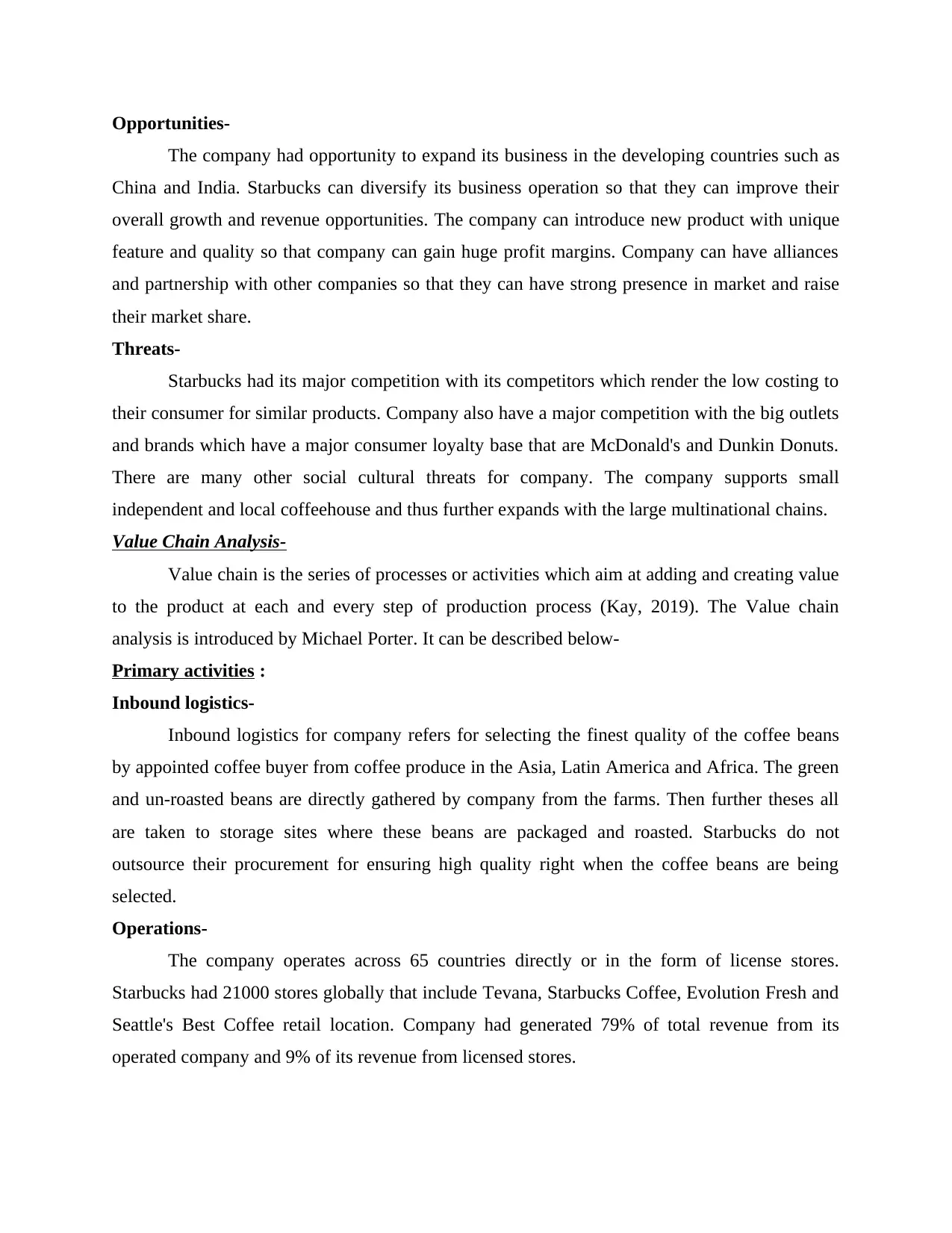
Opportunities-
The company had opportunity to expand its business in the developing countries such as
China and India. Starbucks can diversify its business operation so that they can improve their
overall growth and revenue opportunities. The company can introduce new product with unique
feature and quality so that company can gain huge profit margins. Company can have alliances
and partnership with other companies so that they can have strong presence in market and raise
their market share.
Threats-
Starbucks had its major competition with its competitors which render the low costing to
their consumer for similar products. Company also have a major competition with the big outlets
and brands which have a major consumer loyalty base that are McDonald's and Dunkin Donuts.
There are many other social cultural threats for company. The company supports small
independent and local coffeehouse and thus further expands with the large multinational chains.
Value Chain Analysis-
Value chain is the series of processes or activities which aim at adding and creating value
to the product at each and every step of production process (Kay, 2019). The Value chain
analysis is introduced by Michael Porter. It can be described below-
Primary activities :
Inbound logistics-
Inbound logistics for company refers for selecting the finest quality of the coffee beans
by appointed coffee buyer from coffee produce in the Asia, Latin America and Africa. The green
and un-roasted beans are directly gathered by company from the farms. Then further theses all
are taken to storage sites where these beans are packaged and roasted. Starbucks do not
outsource their procurement for ensuring high quality right when the coffee beans are being
selected.
Operations-
The company operates across 65 countries directly or in the form of license stores.
Starbucks had 21000 stores globally that include Tevana, Starbucks Coffee, Evolution Fresh and
Seattle's Best Coffee retail location. Company had generated 79% of total revenue from its
operated company and 9% of its revenue from licensed stores.
The company had opportunity to expand its business in the developing countries such as
China and India. Starbucks can diversify its business operation so that they can improve their
overall growth and revenue opportunities. The company can introduce new product with unique
feature and quality so that company can gain huge profit margins. Company can have alliances
and partnership with other companies so that they can have strong presence in market and raise
their market share.
Threats-
Starbucks had its major competition with its competitors which render the low costing to
their consumer for similar products. Company also have a major competition with the big outlets
and brands which have a major consumer loyalty base that are McDonald's and Dunkin Donuts.
There are many other social cultural threats for company. The company supports small
independent and local coffeehouse and thus further expands with the large multinational chains.
Value Chain Analysis-
Value chain is the series of processes or activities which aim at adding and creating value
to the product at each and every step of production process (Kay, 2019). The Value chain
analysis is introduced by Michael Porter. It can be described below-
Primary activities :
Inbound logistics-
Inbound logistics for company refers for selecting the finest quality of the coffee beans
by appointed coffee buyer from coffee produce in the Asia, Latin America and Africa. The green
and un-roasted beans are directly gathered by company from the farms. Then further theses all
are taken to storage sites where these beans are packaged and roasted. Starbucks do not
outsource their procurement for ensuring high quality right when the coffee beans are being
selected.
Operations-
The company operates across 65 countries directly or in the form of license stores.
Starbucks had 21000 stores globally that include Tevana, Starbucks Coffee, Evolution Fresh and
Seattle's Best Coffee retail location. Company had generated 79% of total revenue from its
operated company and 9% of its revenue from licensed stores.
Secure Best Marks with AI Grader
Need help grading? Try our AI Grader for instant feedback on your assignments.
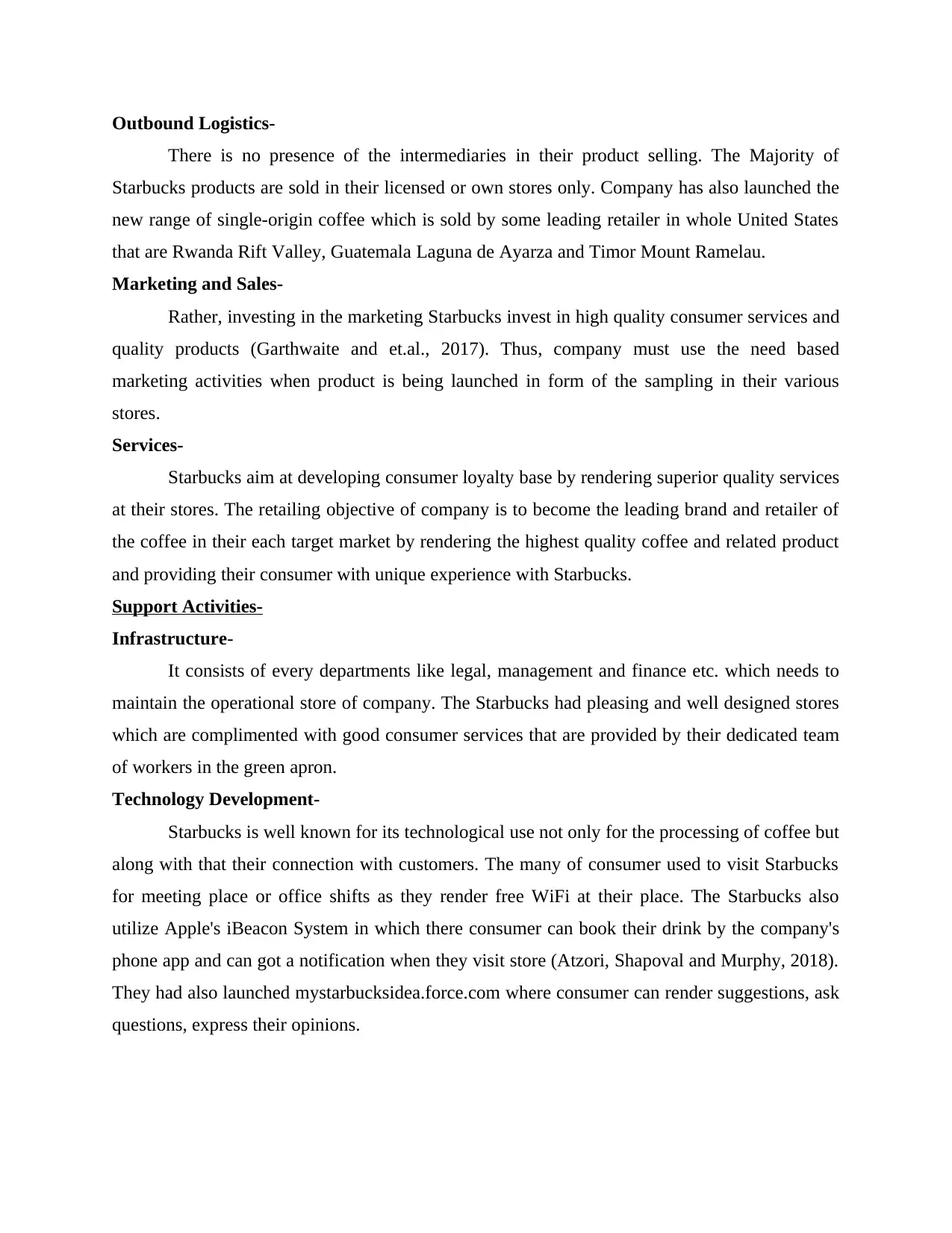
Outbound Logistics-
There is no presence of the intermediaries in their product selling. The Majority of
Starbucks products are sold in their licensed or own stores only. Company has also launched the
new range of single-origin coffee which is sold by some leading retailer in whole United States
that are Rwanda Rift Valley, Guatemala Laguna de Ayarza and Timor Mount Ramelau.
Marketing and Sales-
Rather, investing in the marketing Starbucks invest in high quality consumer services and
quality products (Garthwaite and et.al., 2017). Thus, company must use the need based
marketing activities when product is being launched in form of the sampling in their various
stores.
Services-
Starbucks aim at developing consumer loyalty base by rendering superior quality services
at their stores. The retailing objective of company is to become the leading brand and retailer of
the coffee in their each target market by rendering the highest quality coffee and related product
and providing their consumer with unique experience with Starbucks.
Support Activities-
Infrastructure-
It consists of every departments like legal, management and finance etc. which needs to
maintain the operational store of company. The Starbucks had pleasing and well designed stores
which are complimented with good consumer services that are provided by their dedicated team
of workers in the green apron.
Technology Development-
Starbucks is well known for its technological use not only for the processing of coffee but
along with that their connection with customers. The many of consumer used to visit Starbucks
for meeting place or office shifts as they render free WiFi at their place. The Starbucks also
utilize Apple's iBeacon System in which there consumer can book their drink by the company's
phone app and can got a notification when they visit store (Atzori, Shapoval and Murphy, 2018).
They had also launched mystarbucksidea.force.com where consumer can render suggestions, ask
questions, express their opinions.
There is no presence of the intermediaries in their product selling. The Majority of
Starbucks products are sold in their licensed or own stores only. Company has also launched the
new range of single-origin coffee which is sold by some leading retailer in whole United States
that are Rwanda Rift Valley, Guatemala Laguna de Ayarza and Timor Mount Ramelau.
Marketing and Sales-
Rather, investing in the marketing Starbucks invest in high quality consumer services and
quality products (Garthwaite and et.al., 2017). Thus, company must use the need based
marketing activities when product is being launched in form of the sampling in their various
stores.
Services-
Starbucks aim at developing consumer loyalty base by rendering superior quality services
at their stores. The retailing objective of company is to become the leading brand and retailer of
the coffee in their each target market by rendering the highest quality coffee and related product
and providing their consumer with unique experience with Starbucks.
Support Activities-
Infrastructure-
It consists of every departments like legal, management and finance etc. which needs to
maintain the operational store of company. The Starbucks had pleasing and well designed stores
which are complimented with good consumer services that are provided by their dedicated team
of workers in the green apron.
Technology Development-
Starbucks is well known for its technological use not only for the processing of coffee but
along with that their connection with customers. The many of consumer used to visit Starbucks
for meeting place or office shifts as they render free WiFi at their place. The Starbucks also
utilize Apple's iBeacon System in which there consumer can book their drink by the company's
phone app and can got a notification when they visit store (Atzori, Shapoval and Murphy, 2018).
They had also launched mystarbucksidea.force.com where consumer can render suggestions, ask
questions, express their opinions.
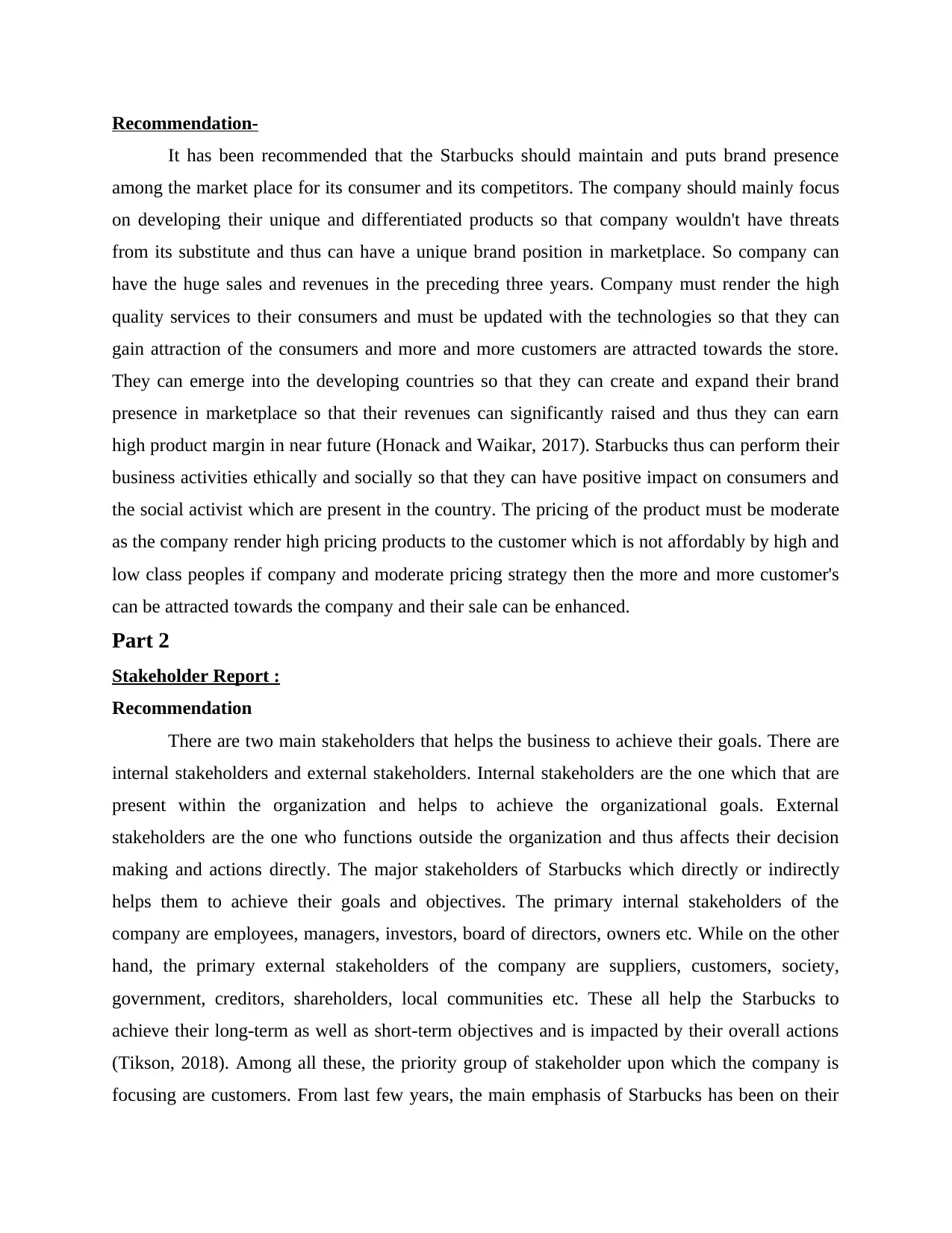
Recommendation-
It has been recommended that the Starbucks should maintain and puts brand presence
among the market place for its consumer and its competitors. The company should mainly focus
on developing their unique and differentiated products so that company wouldn't have threats
from its substitute and thus can have a unique brand position in marketplace. So company can
have the huge sales and revenues in the preceding three years. Company must render the high
quality services to their consumers and must be updated with the technologies so that they can
gain attraction of the consumers and more and more customers are attracted towards the store.
They can emerge into the developing countries so that they can create and expand their brand
presence in marketplace so that their revenues can significantly raised and thus they can earn
high product margin in near future (Honack and Waikar, 2017). Starbucks thus can perform their
business activities ethically and socially so that they can have positive impact on consumers and
the social activist which are present in the country. The pricing of the product must be moderate
as the company render high pricing products to the customer which is not affordably by high and
low class peoples if company and moderate pricing strategy then the more and more customer's
can be attracted towards the company and their sale can be enhanced.
Part 2
Stakeholder Report :
Recommendation
There are two main stakeholders that helps the business to achieve their goals. There are
internal stakeholders and external stakeholders. Internal stakeholders are the one which that are
present within the organization and helps to achieve the organizational goals. External
stakeholders are the one who functions outside the organization and thus affects their decision
making and actions directly. The major stakeholders of Starbucks which directly or indirectly
helps them to achieve their goals and objectives. The primary internal stakeholders of the
company are employees, managers, investors, board of directors, owners etc. While on the other
hand, the primary external stakeholders of the company are suppliers, customers, society,
government, creditors, shareholders, local communities etc. These all help the Starbucks to
achieve their long-term as well as short-term objectives and is impacted by their overall actions
(Tikson, 2018). Among all these, the priority group of stakeholder upon which the company is
focusing are customers. From last few years, the main emphasis of Starbucks has been on their
It has been recommended that the Starbucks should maintain and puts brand presence
among the market place for its consumer and its competitors. The company should mainly focus
on developing their unique and differentiated products so that company wouldn't have threats
from its substitute and thus can have a unique brand position in marketplace. So company can
have the huge sales and revenues in the preceding three years. Company must render the high
quality services to their consumers and must be updated with the technologies so that they can
gain attraction of the consumers and more and more customers are attracted towards the store.
They can emerge into the developing countries so that they can create and expand their brand
presence in marketplace so that their revenues can significantly raised and thus they can earn
high product margin in near future (Honack and Waikar, 2017). Starbucks thus can perform their
business activities ethically and socially so that they can have positive impact on consumers and
the social activist which are present in the country. The pricing of the product must be moderate
as the company render high pricing products to the customer which is not affordably by high and
low class peoples if company and moderate pricing strategy then the more and more customer's
can be attracted towards the company and their sale can be enhanced.
Part 2
Stakeholder Report :
Recommendation
There are two main stakeholders that helps the business to achieve their goals. There are
internal stakeholders and external stakeholders. Internal stakeholders are the one which that are
present within the organization and helps to achieve the organizational goals. External
stakeholders are the one who functions outside the organization and thus affects their decision
making and actions directly. The major stakeholders of Starbucks which directly or indirectly
helps them to achieve their goals and objectives. The primary internal stakeholders of the
company are employees, managers, investors, board of directors, owners etc. While on the other
hand, the primary external stakeholders of the company are suppliers, customers, society,
government, creditors, shareholders, local communities etc. These all help the Starbucks to
achieve their long-term as well as short-term objectives and is impacted by their overall actions
(Tikson, 2018). Among all these, the priority group of stakeholder upon which the company is
focusing are customers. From last few years, the main emphasis of Starbucks has been on their
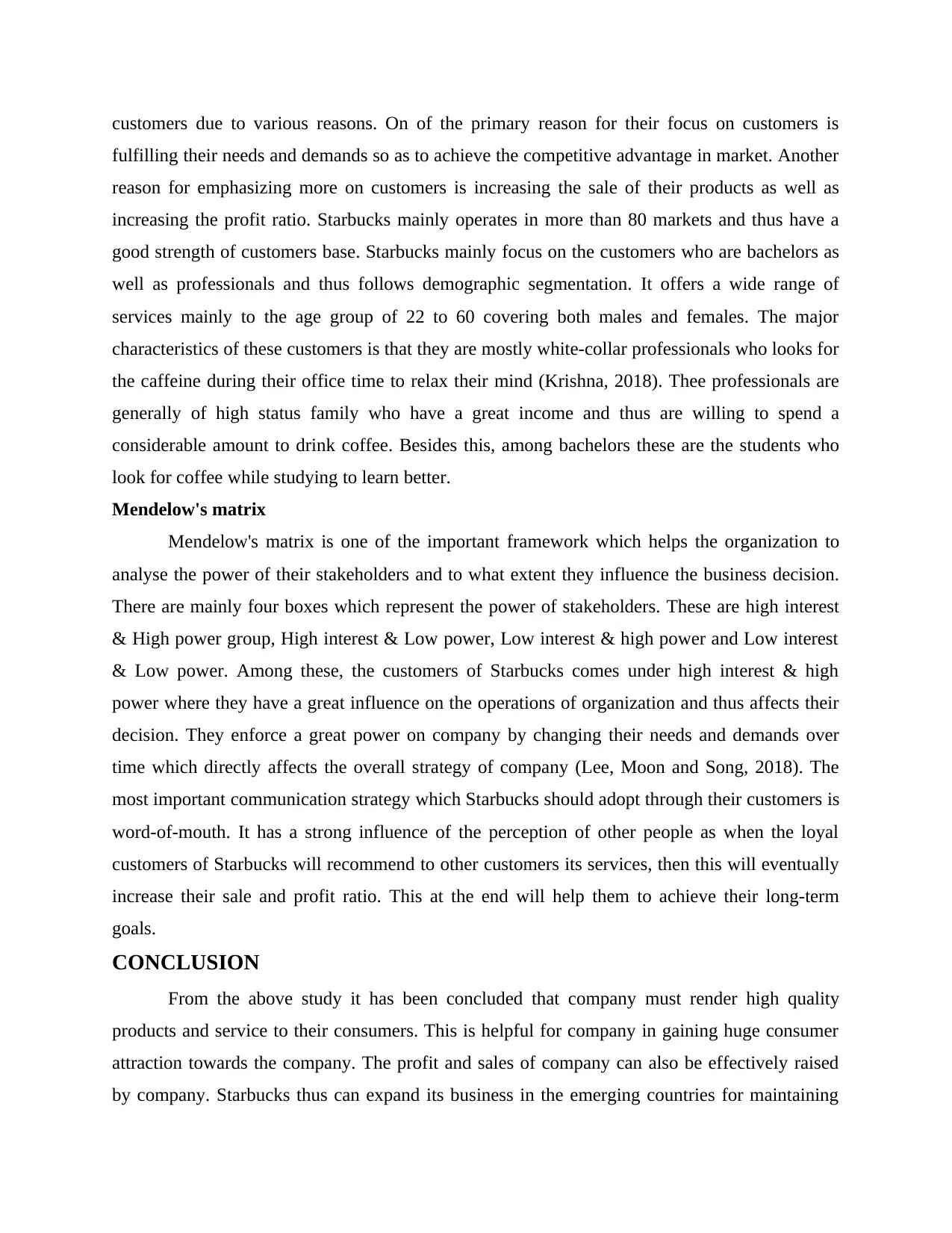
customers due to various reasons. On of the primary reason for their focus on customers is
fulfilling their needs and demands so as to achieve the competitive advantage in market. Another
reason for emphasizing more on customers is increasing the sale of their products as well as
increasing the profit ratio. Starbucks mainly operates in more than 80 markets and thus have a
good strength of customers base. Starbucks mainly focus on the customers who are bachelors as
well as professionals and thus follows demographic segmentation. It offers a wide range of
services mainly to the age group of 22 to 60 covering both males and females. The major
characteristics of these customers is that they are mostly white-collar professionals who looks for
the caffeine during their office time to relax their mind (Krishna, 2018). Thee professionals are
generally of high status family who have a great income and thus are willing to spend a
considerable amount to drink coffee. Besides this, among bachelors these are the students who
look for coffee while studying to learn better.
Mendelow's matrix
Mendelow's matrix is one of the important framework which helps the organization to
analyse the power of their stakeholders and to what extent they influence the business decision.
There are mainly four boxes which represent the power of stakeholders. These are high interest
& High power group, High interest & Low power, Low interest & high power and Low interest
& Low power. Among these, the customers of Starbucks comes under high interest & high
power where they have a great influence on the operations of organization and thus affects their
decision. They enforce a great power on company by changing their needs and demands over
time which directly affects the overall strategy of company (Lee, Moon and Song, 2018). The
most important communication strategy which Starbucks should adopt through their customers is
word-of-mouth. It has a strong influence of the perception of other people as when the loyal
customers of Starbucks will recommend to other customers its services, then this will eventually
increase their sale and profit ratio. This at the end will help them to achieve their long-term
goals.
CONCLUSION
From the above study it has been concluded that company must render high quality
products and service to their consumers. This is helpful for company in gaining huge consumer
attraction towards the company. The profit and sales of company can also be effectively raised
by company. Starbucks thus can expand its business in the emerging countries for maintaining
fulfilling their needs and demands so as to achieve the competitive advantage in market. Another
reason for emphasizing more on customers is increasing the sale of their products as well as
increasing the profit ratio. Starbucks mainly operates in more than 80 markets and thus have a
good strength of customers base. Starbucks mainly focus on the customers who are bachelors as
well as professionals and thus follows demographic segmentation. It offers a wide range of
services mainly to the age group of 22 to 60 covering both males and females. The major
characteristics of these customers is that they are mostly white-collar professionals who looks for
the caffeine during their office time to relax their mind (Krishna, 2018). Thee professionals are
generally of high status family who have a great income and thus are willing to spend a
considerable amount to drink coffee. Besides this, among bachelors these are the students who
look for coffee while studying to learn better.
Mendelow's matrix
Mendelow's matrix is one of the important framework which helps the organization to
analyse the power of their stakeholders and to what extent they influence the business decision.
There are mainly four boxes which represent the power of stakeholders. These are high interest
& High power group, High interest & Low power, Low interest & high power and Low interest
& Low power. Among these, the customers of Starbucks comes under high interest & high
power where they have a great influence on the operations of organization and thus affects their
decision. They enforce a great power on company by changing their needs and demands over
time which directly affects the overall strategy of company (Lee, Moon and Song, 2018). The
most important communication strategy which Starbucks should adopt through their customers is
word-of-mouth. It has a strong influence of the perception of other people as when the loyal
customers of Starbucks will recommend to other customers its services, then this will eventually
increase their sale and profit ratio. This at the end will help them to achieve their long-term
goals.
CONCLUSION
From the above study it has been concluded that company must render high quality
products and service to their consumers. This is helpful for company in gaining huge consumer
attraction towards the company. The profit and sales of company can also be effectively raised
by company. Starbucks thus can expand its business in the emerging countries for maintaining
Paraphrase This Document
Need a fresh take? Get an instant paraphrase of this document with our AI Paraphraser
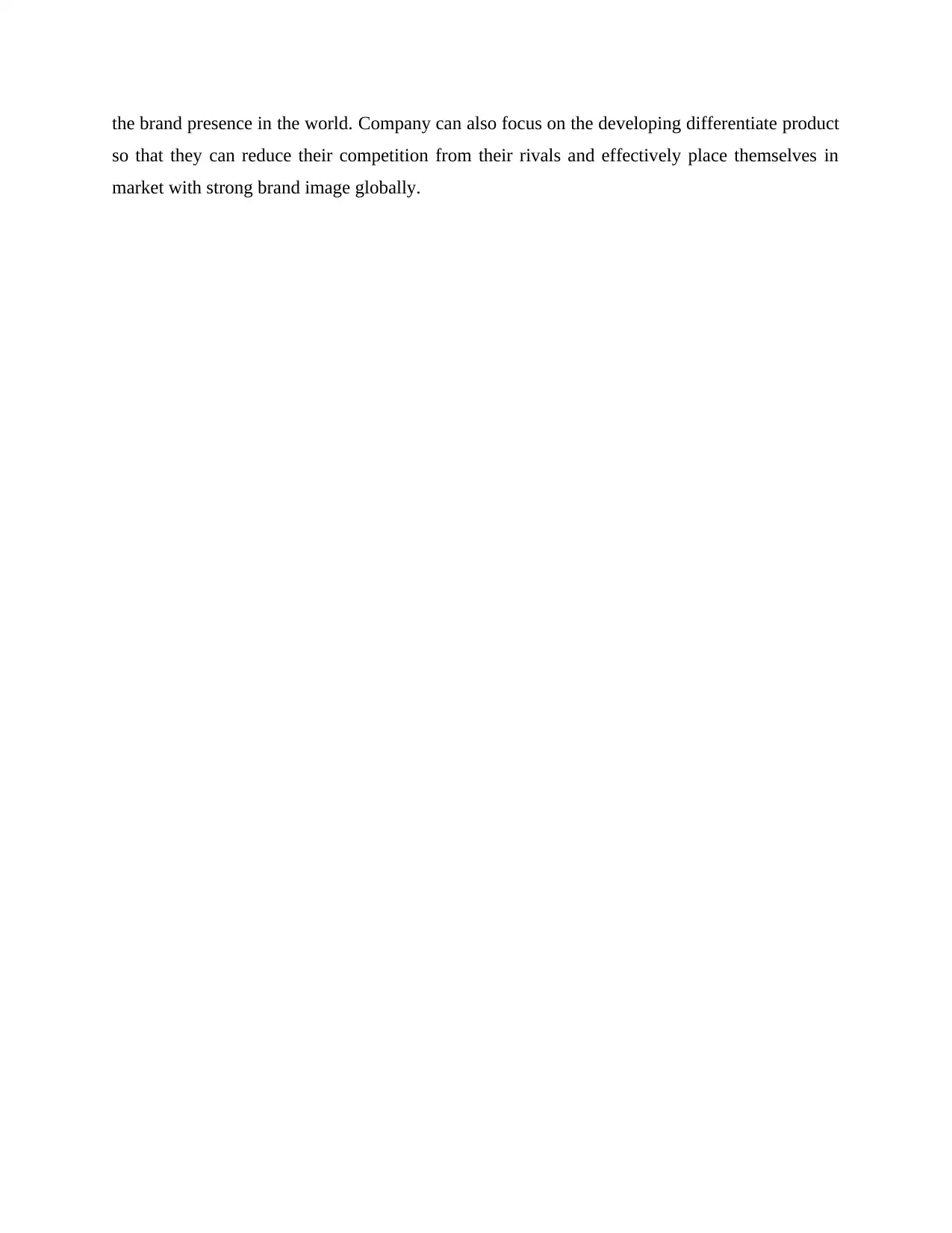
the brand presence in the world. Company can also focus on the developing differentiate product
so that they can reduce their competition from their rivals and effectively place themselves in
market with strong brand image globally.
so that they can reduce their competition from their rivals and effectively place themselves in
market with strong brand image globally.
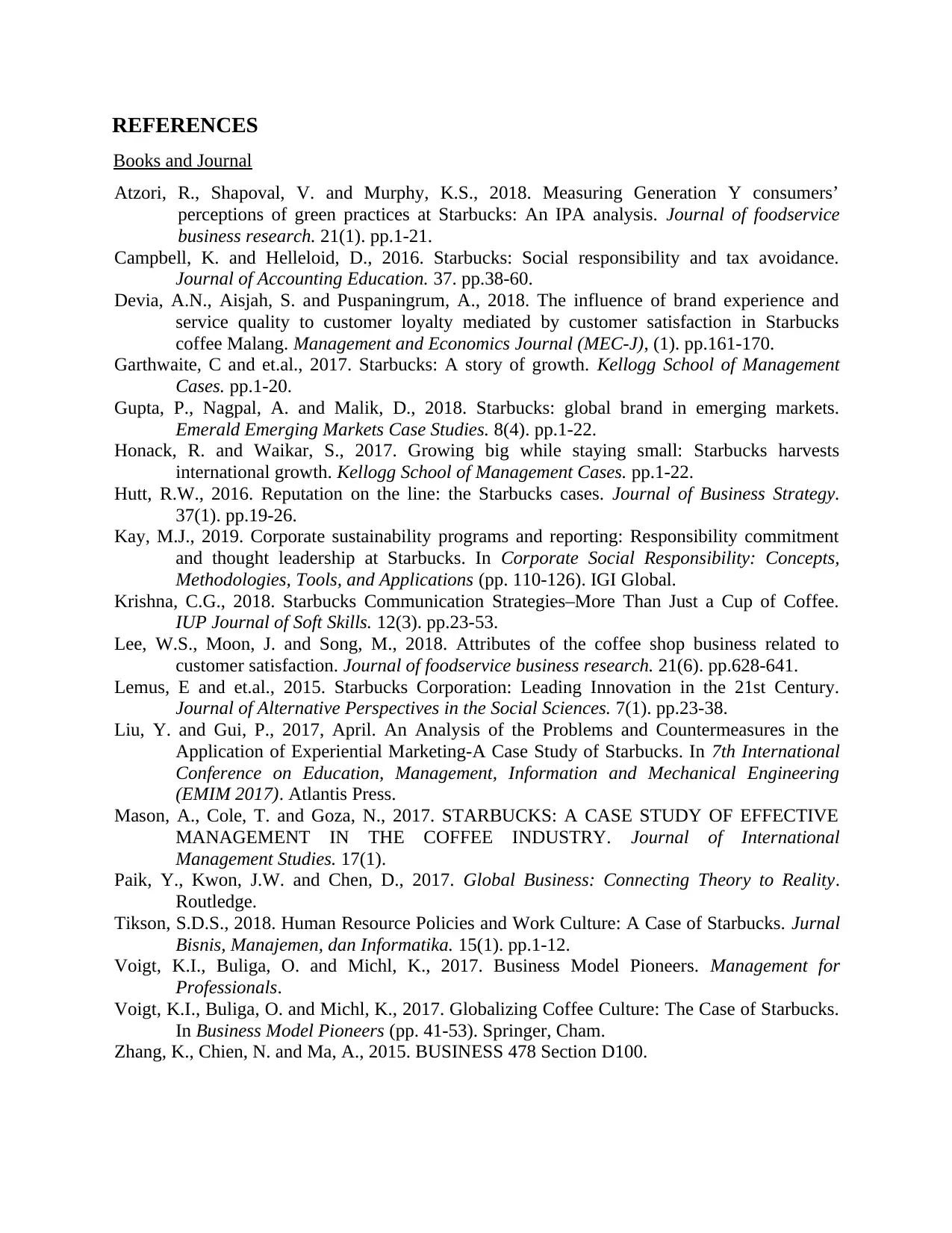
REFERENCES
Books and Journal
Atzori, R., Shapoval, V. and Murphy, K.S., 2018. Measuring Generation Y consumers’
perceptions of green practices at Starbucks: An IPA analysis. Journal of foodservice
business research. 21(1). pp.1-21.
Campbell, K. and Helleloid, D., 2016. Starbucks: Social responsibility and tax avoidance.
Journal of Accounting Education. 37. pp.38-60.
Devia, A.N., Aisjah, S. and Puspaningrum, A., 2018. The influence of brand experience and
service quality to customer loyalty mediated by customer satisfaction in Starbucks
coffee Malang. Management and Economics Journal (MEC-J), (1). pp.161-170.
Garthwaite, C and et.al., 2017. Starbucks: A story of growth. Kellogg School of Management
Cases. pp.1-20.
Gupta, P., Nagpal, A. and Malik, D., 2018. Starbucks: global brand in emerging markets.
Emerald Emerging Markets Case Studies. 8(4). pp.1-22.
Honack, R. and Waikar, S., 2017. Growing big while staying small: Starbucks harvests
international growth. Kellogg School of Management Cases. pp.1-22.
Hutt, R.W., 2016. Reputation on the line: the Starbucks cases. Journal of Business Strategy.
37(1). pp.19-26.
Kay, M.J., 2019. Corporate sustainability programs and reporting: Responsibility commitment
and thought leadership at Starbucks. In Corporate Social Responsibility: Concepts,
Methodologies, Tools, and Applications (pp. 110-126). IGI Global.
Krishna, C.G., 2018. Starbucks Communication Strategies–More Than Just a Cup of Coffee.
IUP Journal of Soft Skills. 12(3). pp.23-53.
Lee, W.S., Moon, J. and Song, M., 2018. Attributes of the coffee shop business related to
customer satisfaction. Journal of foodservice business research. 21(6). pp.628-641.
Lemus, E and et.al., 2015. Starbucks Corporation: Leading Innovation in the 21st Century.
Journal of Alternative Perspectives in the Social Sciences. 7(1). pp.23-38.
Liu, Y. and Gui, P., 2017, April. An Analysis of the Problems and Countermeasures in the
Application of Experiential Marketing-A Case Study of Starbucks. In 7th International
Conference on Education, Management, Information and Mechanical Engineering
(EMIM 2017). Atlantis Press.
Mason, A., Cole, T. and Goza, N., 2017. STARBUCKS: A CASE STUDY OF EFFECTIVE
MANAGEMENT IN THE COFFEE INDUSTRY. Journal of International
Management Studies. 17(1).
Paik, Y., Kwon, J.W. and Chen, D., 2017. Global Business: Connecting Theory to Reality.
Routledge.
Tikson, S.D.S., 2018. Human Resource Policies and Work Culture: A Case of Starbucks. Jurnal
Bisnis, Manajemen, dan Informatika. 15(1). pp.1-12.
Voigt, K.I., Buliga, O. and Michl, K., 2017. Business Model Pioneers. Management for
Professionals.
Voigt, K.I., Buliga, O. and Michl, K., 2017. Globalizing Coffee Culture: The Case of Starbucks.
In Business Model Pioneers (pp. 41-53). Springer, Cham.
Zhang, K., Chien, N. and Ma, A., 2015. BUSINESS 478 Section D100.
Books and Journal
Atzori, R., Shapoval, V. and Murphy, K.S., 2018. Measuring Generation Y consumers’
perceptions of green practices at Starbucks: An IPA analysis. Journal of foodservice
business research. 21(1). pp.1-21.
Campbell, K. and Helleloid, D., 2016. Starbucks: Social responsibility and tax avoidance.
Journal of Accounting Education. 37. pp.38-60.
Devia, A.N., Aisjah, S. and Puspaningrum, A., 2018. The influence of brand experience and
service quality to customer loyalty mediated by customer satisfaction in Starbucks
coffee Malang. Management and Economics Journal (MEC-J), (1). pp.161-170.
Garthwaite, C and et.al., 2017. Starbucks: A story of growth. Kellogg School of Management
Cases. pp.1-20.
Gupta, P., Nagpal, A. and Malik, D., 2018. Starbucks: global brand in emerging markets.
Emerald Emerging Markets Case Studies. 8(4). pp.1-22.
Honack, R. and Waikar, S., 2017. Growing big while staying small: Starbucks harvests
international growth. Kellogg School of Management Cases. pp.1-22.
Hutt, R.W., 2016. Reputation on the line: the Starbucks cases. Journal of Business Strategy.
37(1). pp.19-26.
Kay, M.J., 2019. Corporate sustainability programs and reporting: Responsibility commitment
and thought leadership at Starbucks. In Corporate Social Responsibility: Concepts,
Methodologies, Tools, and Applications (pp. 110-126). IGI Global.
Krishna, C.G., 2018. Starbucks Communication Strategies–More Than Just a Cup of Coffee.
IUP Journal of Soft Skills. 12(3). pp.23-53.
Lee, W.S., Moon, J. and Song, M., 2018. Attributes of the coffee shop business related to
customer satisfaction. Journal of foodservice business research. 21(6). pp.628-641.
Lemus, E and et.al., 2015. Starbucks Corporation: Leading Innovation in the 21st Century.
Journal of Alternative Perspectives in the Social Sciences. 7(1). pp.23-38.
Liu, Y. and Gui, P., 2017, April. An Analysis of the Problems and Countermeasures in the
Application of Experiential Marketing-A Case Study of Starbucks. In 7th International
Conference on Education, Management, Information and Mechanical Engineering
(EMIM 2017). Atlantis Press.
Mason, A., Cole, T. and Goza, N., 2017. STARBUCKS: A CASE STUDY OF EFFECTIVE
MANAGEMENT IN THE COFFEE INDUSTRY. Journal of International
Management Studies. 17(1).
Paik, Y., Kwon, J.W. and Chen, D., 2017. Global Business: Connecting Theory to Reality.
Routledge.
Tikson, S.D.S., 2018. Human Resource Policies and Work Culture: A Case of Starbucks. Jurnal
Bisnis, Manajemen, dan Informatika. 15(1). pp.1-12.
Voigt, K.I., Buliga, O. and Michl, K., 2017. Business Model Pioneers. Management for
Professionals.
Voigt, K.I., Buliga, O. and Michl, K., 2017. Globalizing Coffee Culture: The Case of Starbucks.
In Business Model Pioneers (pp. 41-53). Springer, Cham.
Zhang, K., Chien, N. and Ma, A., 2015. BUSINESS 478 Section D100.
1 out of 15
Related Documents
Your All-in-One AI-Powered Toolkit for Academic Success.
+13062052269
info@desklib.com
Available 24*7 on WhatsApp / Email
![[object Object]](/_next/static/media/star-bottom.7253800d.svg)
Unlock your academic potential
© 2024 | Zucol Services PVT LTD | All rights reserved.





